Pre-Test of a Stand for Testing Fire Resistance of Compressed Hydrogen Storage Systems
Abstract
1. Introduction
- For a passenger car powered by an internal combustion engine, 8 kg of hydrogen, and in the case of using a fuel cell, 4 kg;
- For a truck, 32 kg and 16 kg, respectively;
- For a bus, 41 kg and 20 kg, respectively.
2. Materials and Methods
2.1. Test Stand
2.2. Pre-Test Procedure
- The steel cylinder was placed horizontally so its lower surface was 100 ± 5 mm above the fire source. Then, all the thermocouples were placed, as shown in Figure 8. The thermocouple system was mechanically supported to prevent the thermocouples from changing position during temperature measurement.
- Wind shields were used.
- The rate of fuel flow to the localized and engulfing fire source was determined to obtain the recommended values of heat release by the fire source per unit area (HRR/A). The required flow rate was calculated according to the following formula:HRR/A = (H × Q)/A,where HRR/A is heat release rate per unit area of the fire source, expressed in kilowatts per square meter (kW/m2); H is the lower heating value of the fuel, expressed in megajoules per kilogram (MJ/kg); Q is the fuel flow rate, expressed in grams per second (g/s); and A is the area of the fire source, expressed in square meters (m2). The supply gas is propane.To obtain the recommended HRR/A value [21]:
- For a localized flame of 300 kW/m2, a gas mass flow of 0.85 g/s was used.
- For an engulfing flame of 700 kW/m2, a gas mass flow of 10.6 g/s was used.
- Pre-test duration: 1020 s, including the localized fire phase of 10 min and the engulfing fire phase of 418 s.
- The gas mass flow to the localized burner was constant throughout the test. The gas flow to the engulfing burner began 10 min after the test started and was maintained at the required value until the test was completed.
- Signals from mass flow meters were recorded. During the test, thermocouple temperature data were recorded, and then the 60 s rolling average was calculated.
3. Results
3.1. Measuring Temperatures at Specific Points
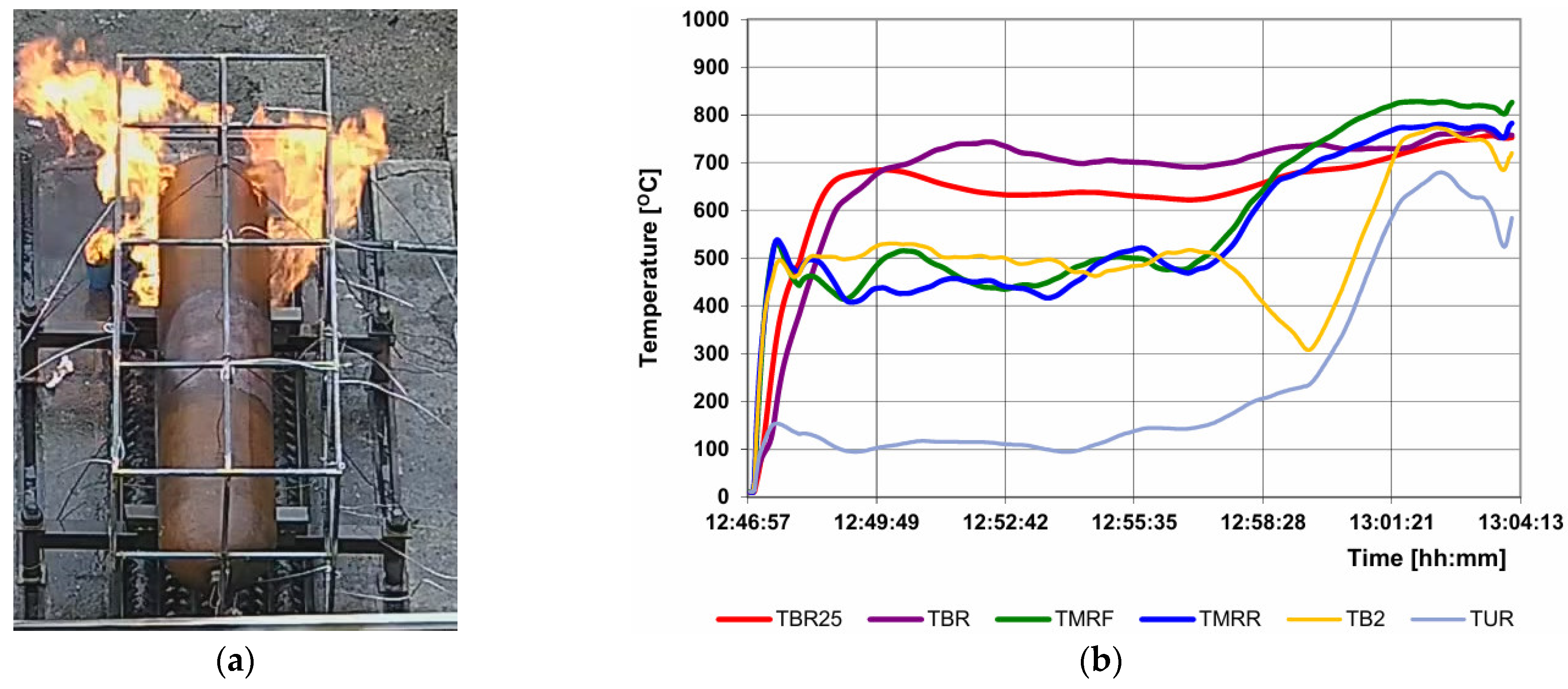
3.2. Measurement of the Fuel Flow Feeding the Burners
4. Discussion
4.1. Verification of Required Temperature Parameters
- TBLOC is the bottom surface temperature of the pre-test cylinder based on TBR.
- TMFLOC is the surface temperature of the front side of the pre-test cylinder based on TMRF.
- TMRLOC is the surface temperature of the rear side of the pre-test cylinder based on TMRR.
- TULOC is the top surface temperature of the pre-test cylinder based on TUR.
- TBLOC25 is the burner monitor below the pre-test cylinder based on TBR25. Thermocouples used to back up or supplement TBR25 may also be included in the calculation of the average temperature of the burner monitors in the localized fire zone.
- TBENG is the bottom surface temperature of the pre-test cylinder based on the average of TBR, TBC, or TBL within the engulfing fire zone.
- TMFENG is the surface temperature of the front side of the pre-test cylinder based on the average of the TMLF, TMCF, and TMRF within the engulfing fire zone.
- TMRENG is the surface temperature of the rear side of the pre-test cylinder based on the average of the TMLR, TMCR, and TMRR within the engulfing fire zone.
- TUENG is the top surface temperature of the pre-test cylinder based on the average of the TUR, TUC, or TUL within the engulfing fire zone.
- TBENG25 is the burner monitor below the pre-test based on the average of the three required thermocouples (TBR25, TBC25, or TBL25 for the pre-test checkout) within the engulfing fire zone. Thermocouples used to back up or supplement the TBR25, TBC25, or TBL25 may also be in included in the calculation of the average temperature of the burner monitor in the engulfing fire zone.
4.2. Establishing Temperature Monitors
- The minimum value for the burner monitor during the localized fire stage (TminLOC25) shall be calculated by subtracting 50 °C from the 60 s rolling average of the TBLOC25. If the resultant minimum values exceed 600 °C, the minimum value is set to 600 °C for the localized fire stage.
- The minimum value for the burner monitor during the engulfing fire stage (TminENG25) shall be calculated by subtracting 50 °C from the 60 s rolling average of the TBENG25. If the resultant minimum values exceed 800 °C, the minimum value is set to 800 °C for the engulfing fire stage.
4.3. Calculation of the Amount of Heat Released by the Burners
5. Conclusions
Author Contributions
Funding
Data Availability Statement
Conflicts of Interest
Abbreviations
| CGH2 | Compressed gaseous hydrogen |
| CHSS | Compressed hydrogen storage systems |
| FC | Fuel cells |
| HRR/A | Heat release rate per unit area of the fire source |
| ICE | Internal combustion engine |
| LH2 | Liquid hydrogen |
| NWP | Nominal working pressure |
References
- Molkov, V. Fundamentals of Hydrogen Safety Engineering I; BookBoon: London, UK, 2012; ISBN 978-87-403-02226-4. [Google Scholar]
- Molkov, V. Fundamentals of Hydrogen Safety Engineering II; BookBoon: London, UK, 2012; ISBN 978-87-403-0279-0. [Google Scholar]
- Kovacs, D.; Rezaei, R.; Englert, F.; Hayduk, C.; Delebinski, T. High Efficiency HD Hydrogen Combustion Engines: Improvement Potentials for Future Regulations. SAE Tech. Pap. 2022, 1, 477. [Google Scholar] [CrossRef]
- Lohse-Busch, H.; Stutenberg, K.; Duoba, M.; Liu, X.; Elgowainy, A.; Wang, M.; Wallner, T.; Richard, B.; Christenson, M. Automotive fuel cell stack and system efficiency and fuel consumption based on vehicle testing on a chassis dynamometer at minus 18 °C to positive 35 °C temperatures. Int. J. Hydrogen Energy 2020, 45, 861–872. [Google Scholar] [CrossRef]
- Hosseini, S.E.; Butler, B. An overview of development and challenges in hydrogen-powered vehicles. Int. J. Green Energy 2020, 17, 13–37. [Google Scholar] [CrossRef]
- Japan DME Forum. DME Handbook [English Edition]; Japan DME Forum (current Japan DME Association): Tokyo, Japan, 2007. [Google Scholar]
- NOW GmbH. Available online: https://www.now-gmbh.de/foerderung/ (accessed on 30 June 2023).
- Leung, M.K.H.; Leung, D.Y.C.; Sumathy, K.; Ni, M. Feasibility Study of Renewable Hydrogen in Hong Kong; HKSAR: Hong Kong, 2004. [Google Scholar]
- Chan, R.W.M. Feasibility Study on Hydrogen Storage with Intermittent Renewables on Island–Case Study of the Canary Islands. Master’s Thesis, University of London, London, UK, 2000. [Google Scholar]
- Habel, C.; Tsurko, E.S.; Timmins, R.L.; Hutschreuther, J.; Kunz, R.; Schuchardt, D.D.; Rosenfeldt, S.; Altstädt, V.; Breu, J. Lightweight Ultra-High-Barrier Liners for Helium and Hydrogen. ACS Nano 2020, 14, 7018–7024. [Google Scholar] [CrossRef] [PubMed]
- Durbin, D.J.; Malardier-Jugroot, C. Review of hydrogen storage techniques for on board vehicle applications. Int. J. Hydrogen Energy 2013, 38, 14595–14617. [Google Scholar] [CrossRef]
- Mori, D.; Hirose, K. Recent challenges of hydrogen storage technologies for fuel cell vehicles. Int. J. Hydrogen Energy 2008, 34, 4569–4574. [Google Scholar] [CrossRef]
- Yamashita, A.; Kondo, M.; Goto, S.; Ogami, N. Development of High-Pressure Hydrogen Storage System for the Toyota “Mirai”. SAE Tech. Pap. 2015, 1, 1169. [Google Scholar] [CrossRef]
- Abohamzeh, E.; Salehi, F.; Sheikholeslami, M.; Abbassi, R.; Khan, F. Review of hydrogen safety during storage, transmission, and application processes. J. Loss Prev. Process Ind. 2021, 72, 104569. [Google Scholar] [CrossRef]
- Moradi, R.; Groth, K.M. Hydrogen storage and delivery: Review of the state of the art technologies and risk and reliability analysis. Int. J. Hydrogen Energy 2019, 44, 12254–12269. [Google Scholar] [CrossRef]
- Rivard, E.; Trudeau, M.; Zaghib, K. Hydrogen Storage for Mobility: A Review. Materials 2019, 12, 1973. [Google Scholar] [CrossRef] [PubMed]
- Hupp, N.; Stahl, U.; Kunze, K.; Wilde, P.; Sinske, H.; Hinrichsen, O. Influence of fire intensity, fire impingement area and internal pressure on the fire resistance of composite pressure vessels for the storage of hydrogen in automobile applications. Fire Saf. J. 2019, 104, 1–7. [Google Scholar] [CrossRef]
- Molkov, V.; Kashkarov, S.; Makarov, D.; Fletcher, J.; Rattigan, W. Explosion free in fire self-venting (TPRD-less) Type IV tanks: Validation under extreme impinging 70 MPa hydrogen jet fire conditions. Int. J. Hydrogen Energy 2023, 48, 40117–40126. [Google Scholar] [CrossRef]
- Molkov, V.; Kashkarov, S.; Makarov, D. Explosion free in fire self-venting (TPRD-less) composite tanks: Performance during fire intervention. Int. J. Hydrogen Energy 2024, 50, 804–814. [Google Scholar] [CrossRef]
- European Union. Regulation No 134 The United Nations Economic Commission for Europe (UNECE)—Uniform Provisions Concerning the Approval of Motor Vehicles and Their Components with Regard to the Safety-Related Performance of Hydrogen-Fuelled Vehicles (HFCV)—Supplement 03 to the Original Version of the Regulation; European Union: Geneva, Switzerland, 2019. [Google Scholar]
- UN Economic Commission for Europe. (IWG on HFCV) Proposal for Amendment 1 to UN Global Technical Regulation No. 13. Phase 2 (Hydrogen and Fuel Cell Vehicles); UN Economic Commission for Europe: Geneva, Switzerland, 2023. [Google Scholar]
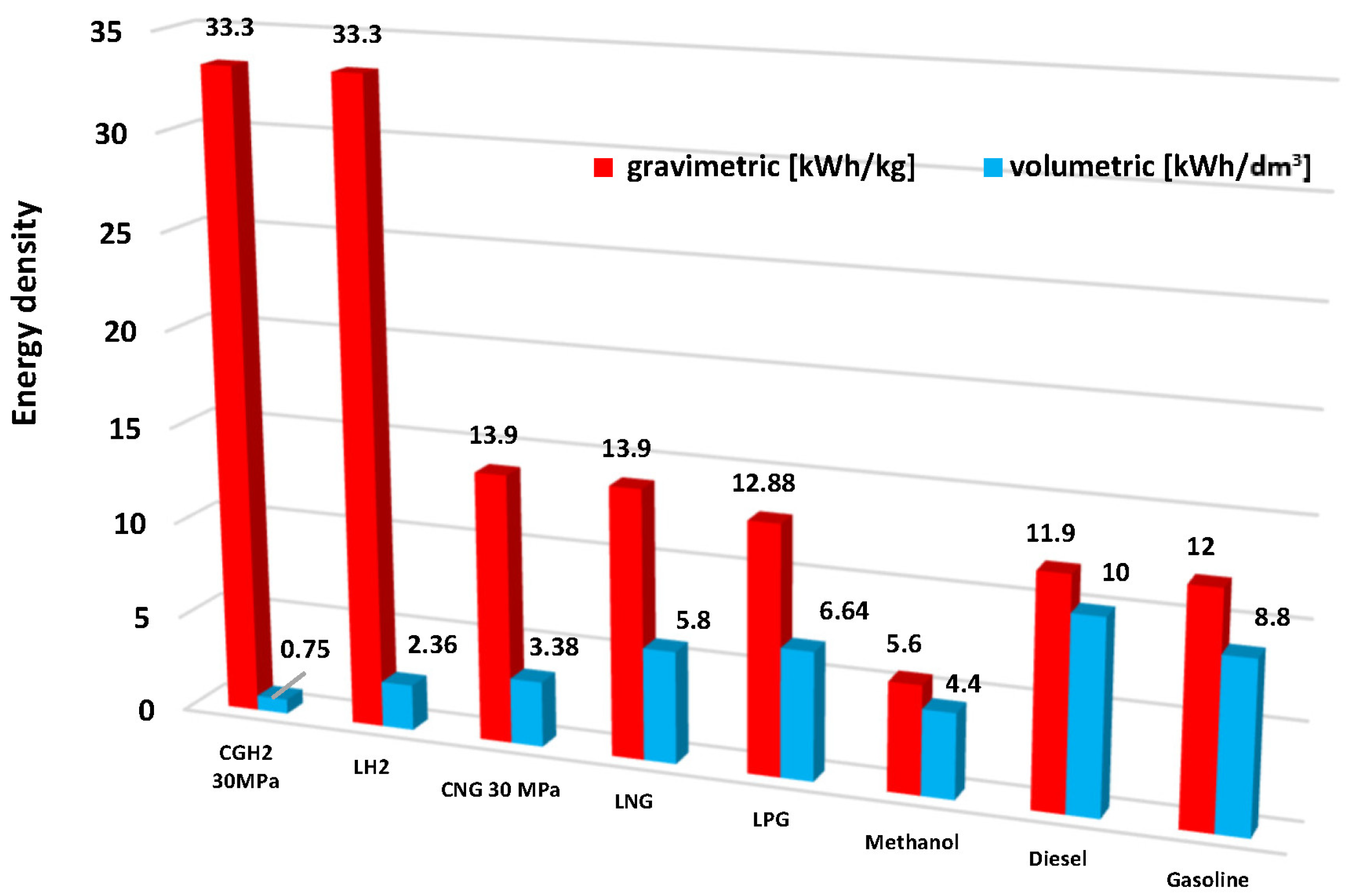



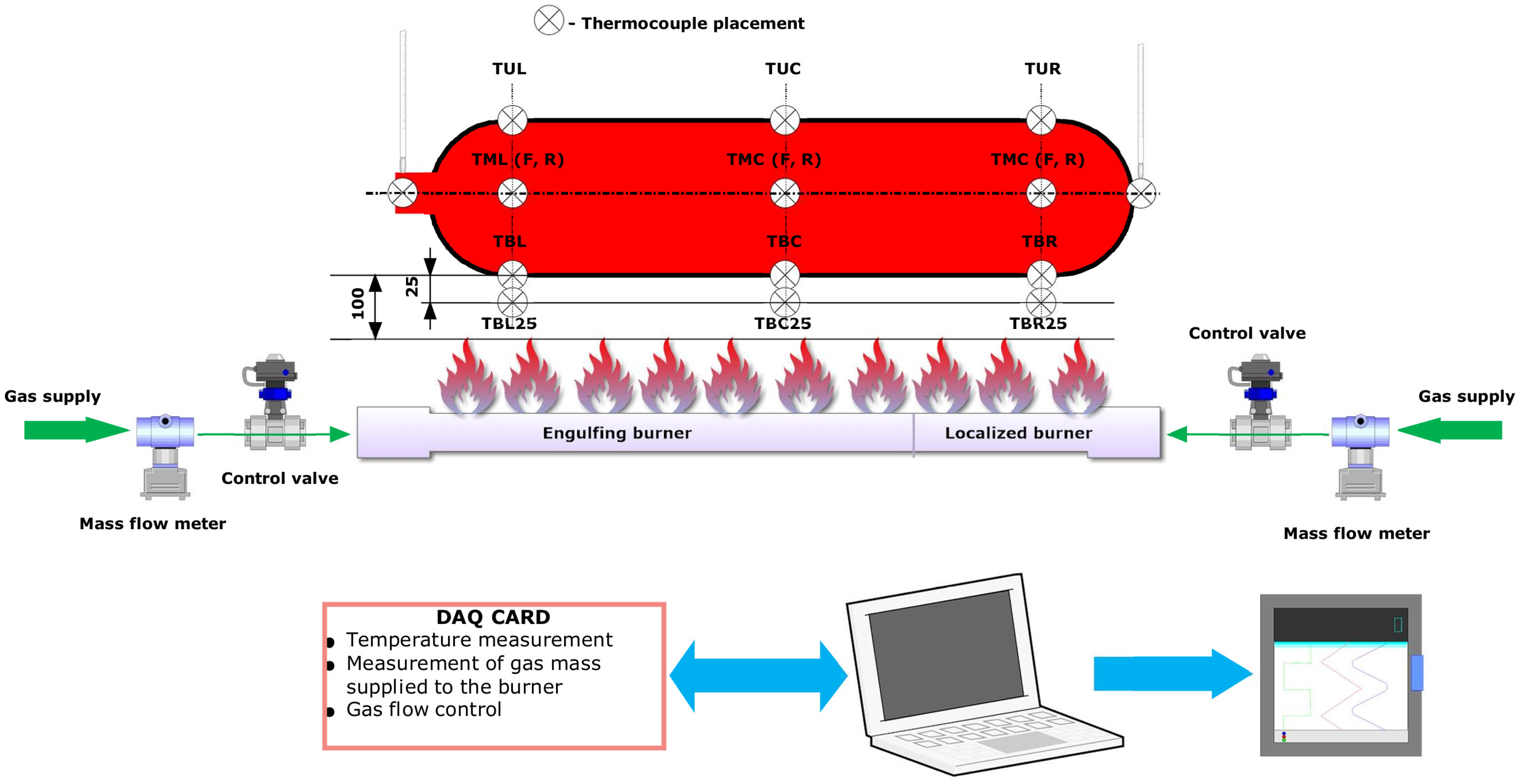
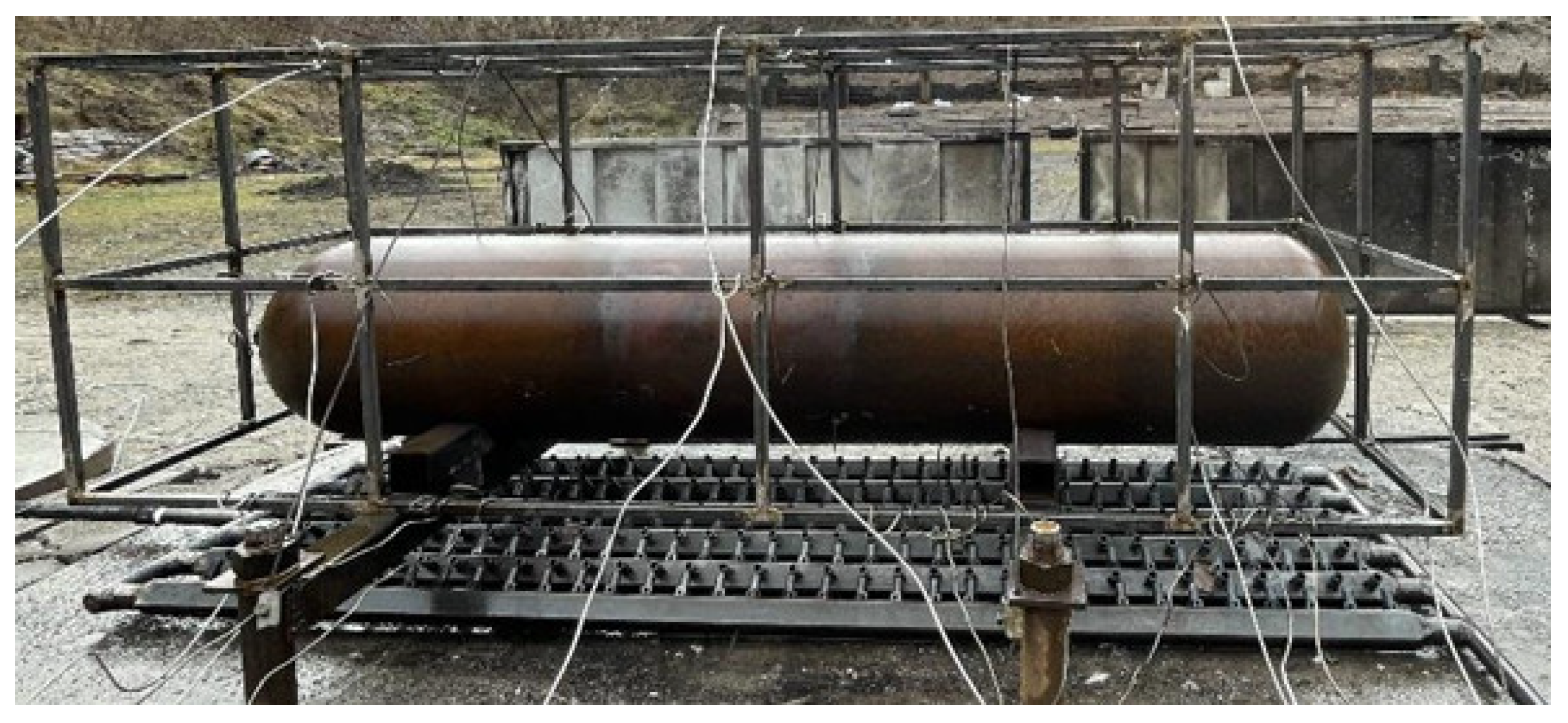

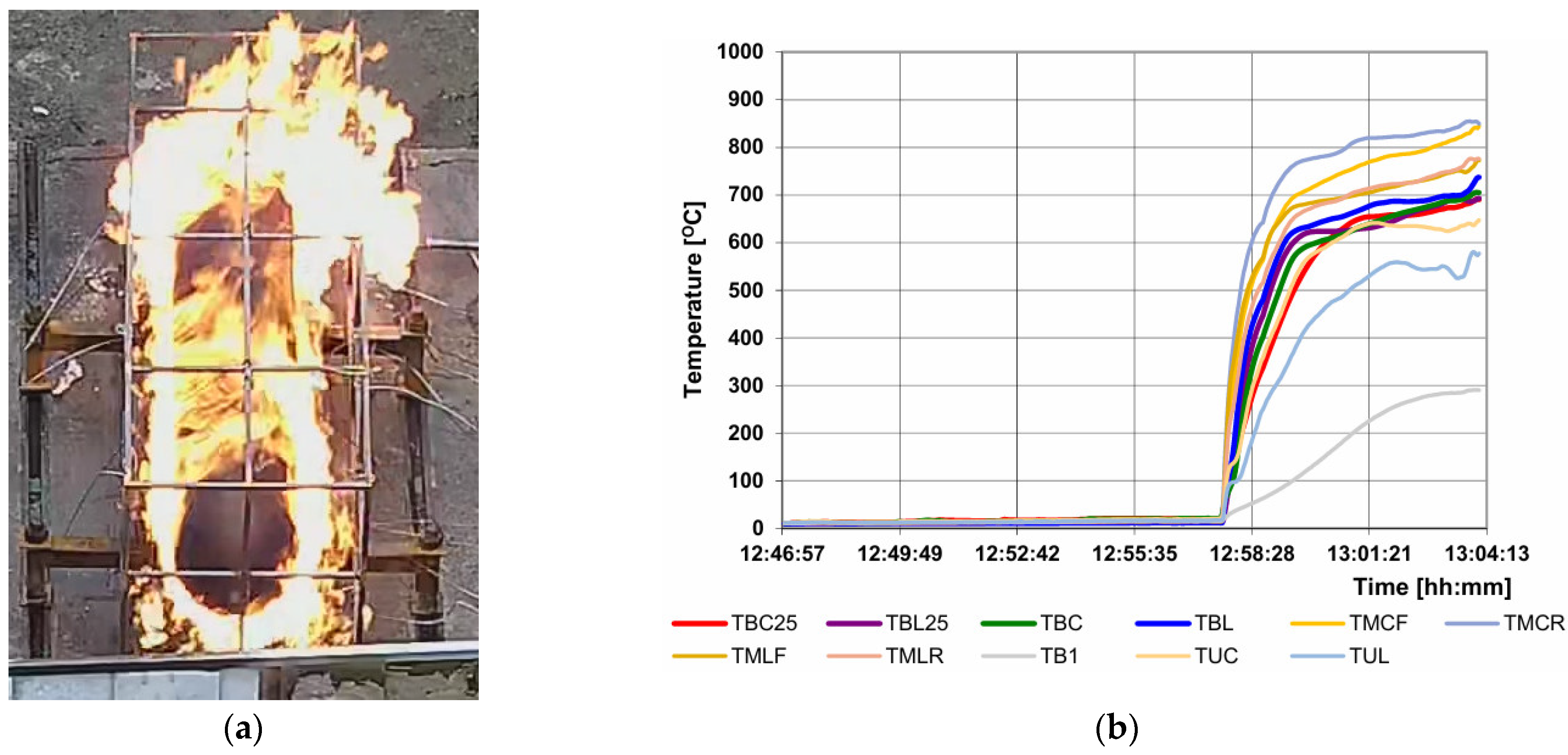
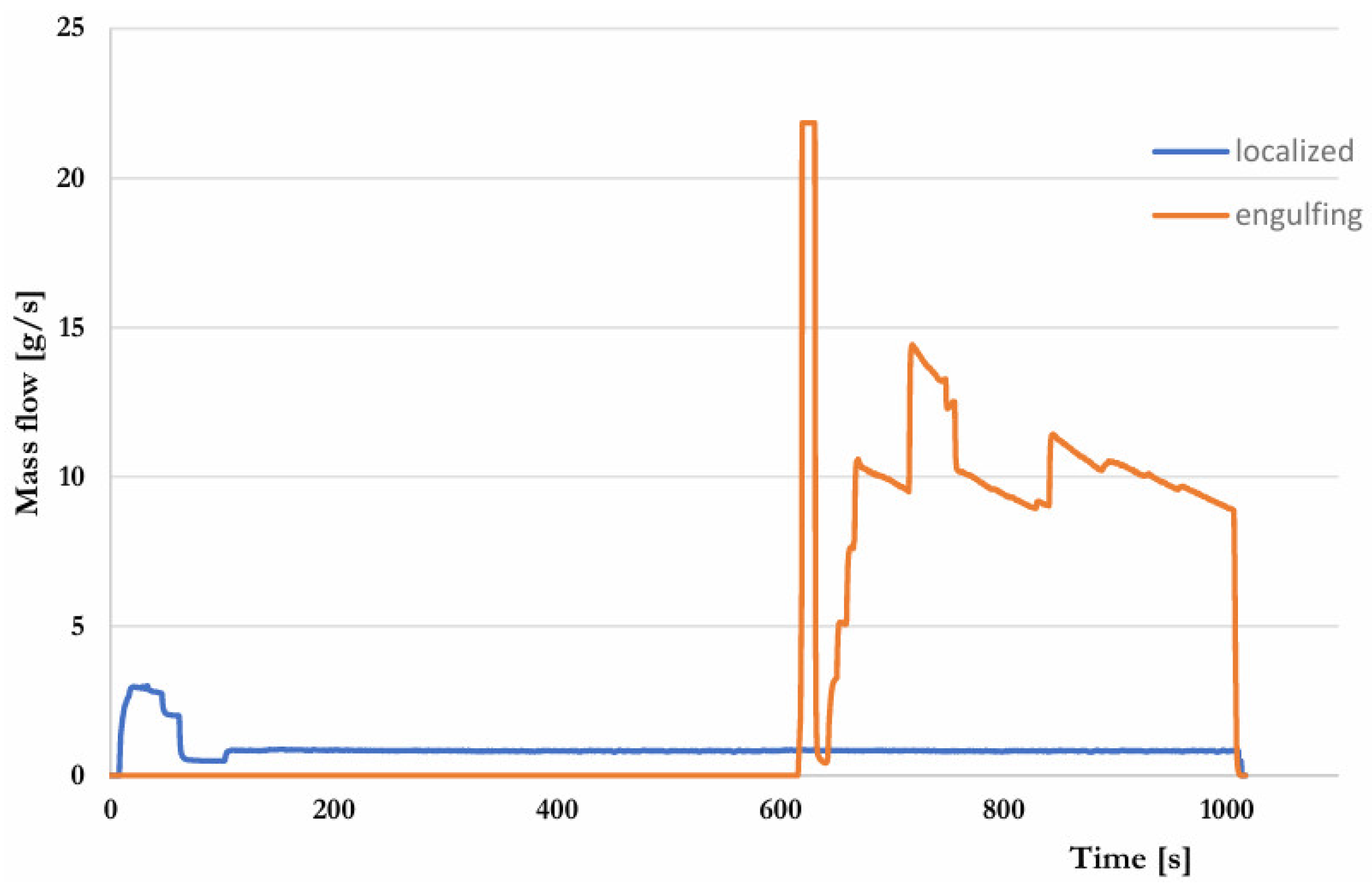

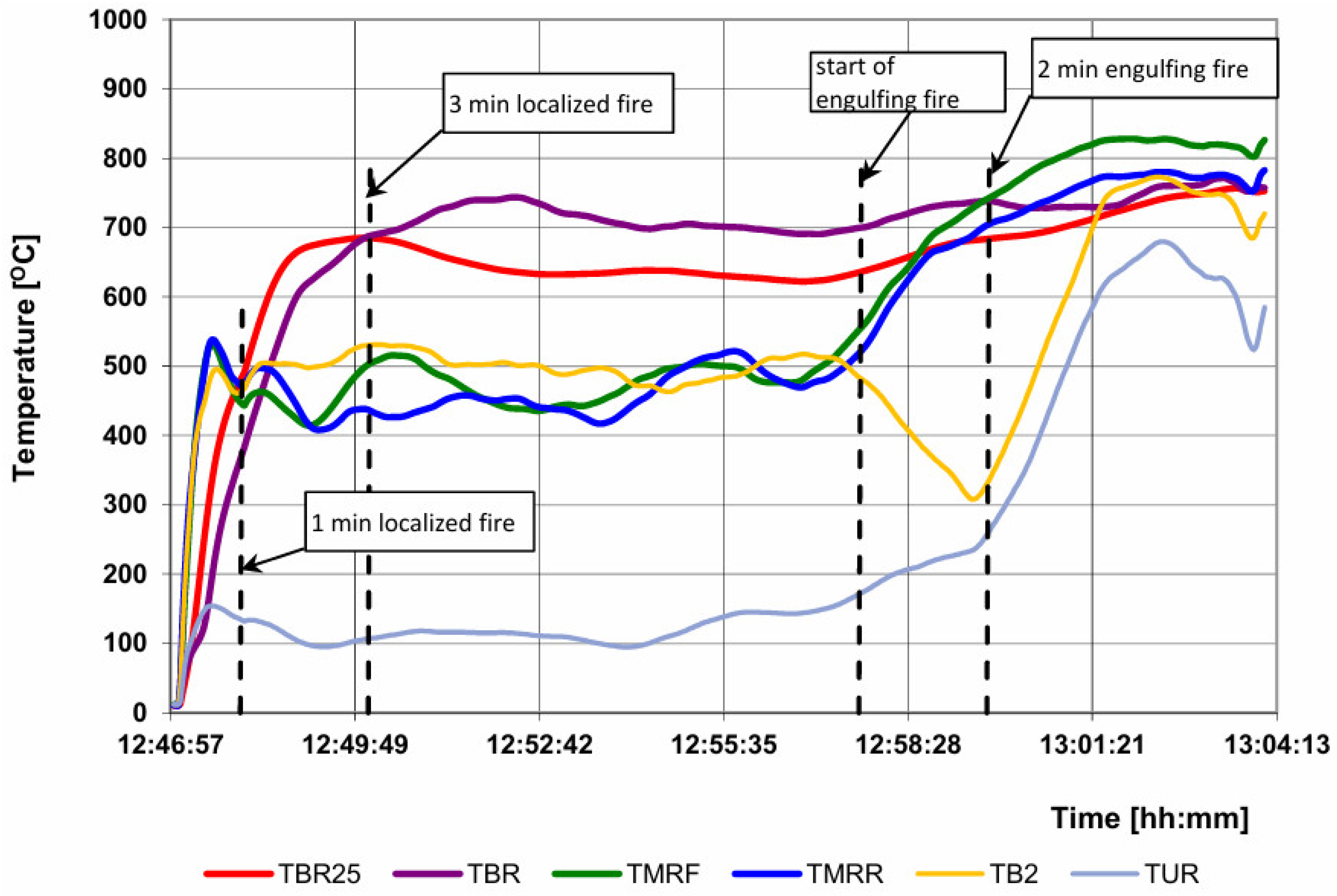

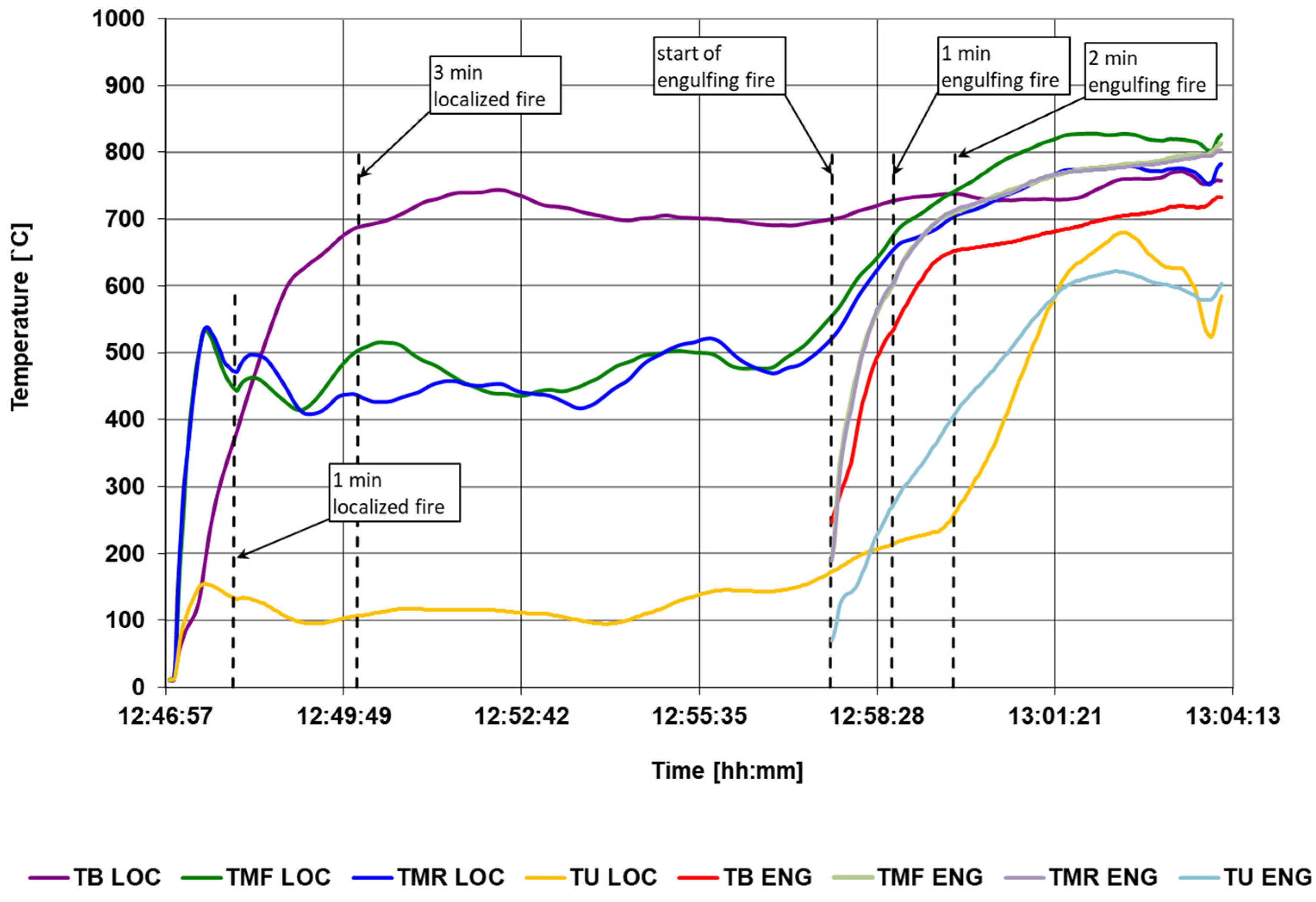

| Item | Description |
|---|---|
| Nozzle type: | LPG fuel nozzle with air pre-mix |
| LPG orifice in nozzle | 1.0 ± 0.1 mm ID |
| Air ports in nozzle | Four (4) holes, 6.4 mm ± 0.6 mm ID |
| Fuel/air mixing tube in nozzle | 10 ± 1 mm ID |
| Number of rails | 6 |
| Center-to-center spacing of rails | 100 ± 10 mm |
| Center-to-center nozzle spacing Along the rails | 50 ± 5 mm |
| Zone | Parameter | Value |
|---|---|---|
| Localized fire zone | Length | 25 cm |
| Width | 50 cm | |
| Number of nozzles | 60 | |
| Surface | 0.125 m2 | |
| Engulfing fire zone | Length | 140 cm |
| Width | 50 cm | |
| Number of nozzles | 280 | |
| Surface | 0.7 m2 |
| Allowable Temperature Range in Cylinder Region * | Localized Burner | Engulfing Burner | ||
|---|---|---|---|---|
| Required | Obtained | Required | Obtained | |
| Bottom | 450 °C < TBLOC < 750 °C | Min. 688 °C Max. 744 °C | TBENG > 600 °C | Min. 652 °C |
| Sides | TMFLOC < 750 °C and TMRLOC < 750 °C | Max. 516 °C Max. 522 °C | ||
| Top | TULOC < 300 °C | Max. 148 °C | TUENG > 100 °C and TUENG < TBENG when TUENG > 750 °C | Min. 410 °C Max. 622 °C |
| Burner Power Settings | Specific Heat Release Rate HRR/A [kW/m2] | Gas Mass Flow [g/s] | |
|---|---|---|---|
| Localized Burner | Allowable | 200–500 | 0.54–1.36 |
| Suggested | 300 | 0.81 | |
| Obtained | 312.8 | 0.85 | |
| Engulfing Burner | Allowable | 400–1000 | 6.08–15.51 |
| Suggested | 700 | 10.65 | |
| Obtained | 696.57 | 10.6 | |
Disclaimer/Publisher’s Note: The statements, opinions and data contained in all publications are solely those of the individual author(s) and contributor(s) and not of MDPI and/or the editor(s). MDPI and/or the editor(s) disclaim responsibility for any injury to people or property resulting from any ideas, methods, instructions or products referred to in the content. |
© 2025 by the authors. Licensee MDPI, Basel, Switzerland. This article is an open access article distributed under the terms and conditions of the Creative Commons Attribution (CC BY) license (https://creativecommons.org/licenses/by/4.0/).
Share and Cite
Kubica, G.; Flekiewicz, M.; Fabiś, P.; Marzec, P.; Hemlecki, P. Pre-Test of a Stand for Testing Fire Resistance of Compressed Hydrogen Storage Systems. Energies 2025, 18, 1368. https://doi.org/10.3390/en18061368
Kubica G, Flekiewicz M, Fabiś P, Marzec P, Hemlecki P. Pre-Test of a Stand for Testing Fire Resistance of Compressed Hydrogen Storage Systems. Energies. 2025; 18(6):1368. https://doi.org/10.3390/en18061368
Chicago/Turabian StyleKubica, Grzegorz, Marek Flekiewicz, Paweł Fabiś, Paweł Marzec, and Piotr Hemlecki. 2025. "Pre-Test of a Stand for Testing Fire Resistance of Compressed Hydrogen Storage Systems" Energies 18, no. 6: 1368. https://doi.org/10.3390/en18061368
APA StyleKubica, G., Flekiewicz, M., Fabiś, P., Marzec, P., & Hemlecki, P. (2025). Pre-Test of a Stand for Testing Fire Resistance of Compressed Hydrogen Storage Systems. Energies, 18(6), 1368. https://doi.org/10.3390/en18061368







